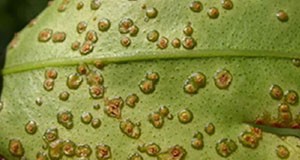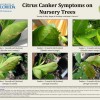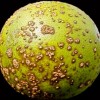This new 5-page article presents an overview of the use of antibiotics in agriculture. Several of the most severe bacterial diseases of tree fruit and other crops are discussed and their integrated management, which includes the use of antibiotics, is described. Antibiotic use for plant disease protection is compared with the use of antibiotics in livestock production, and their future and limitations in plant production are discussed. Written by Leigh Archer, Ute Albrecht, and Pamela Roberts, and published by the UF/IFAS Horticultural Sciences Department.
https://edis.ifas.ufl.edu/hs1366
Tag: Citrus Canker
Formation of Citrus Canker Lesions
Citrus canker is a non-systemic bacterial disease that affects citrus trees in both the citrus nursery and in commercial plantings. This poster is designed to assist citrus nursery workers in the identification of citrus canker. This one-page document was written by Jamie Burrow, Megan Dewdney, Ajia Paolillo, and Tim Riley and published by the UF/IFAS Plant Pathology Department.
http://edis.ifas.ufl.edu/pp346
Dooryard Citrus Production: Asiatic Citrus Canker Disease

Asiatic citrus canker is a bacterial disease of citrus that causes necrotic lesions on leaves, stems, and fruit of infected trees. Severe cases can cause defoliation, premature fruit drop, twig dieback, and general tree decline.This eight-page fact sheet explains the history of citrus canker in Florida, describes the symptoms of citrus canker, and details how to manage the spread of citrus canker disease by preventing infection and controlling existing infections. Written by Megan M. Dewdney, Jamie D. Burrow, James H. Graham, Timothy M. Spann, and Ryan A. Atwood, and published by the Horticultural Sciences department.
http://edis.ifas.ufl.edu/pp323
Sintomas de Cancro Citrico en Arboles de Vivero (PP307)
 This is a two-page illustrated identification sheet for citrus canker symptoms that appear in citrus nurseries. Written by Timothy D. Riley, Megan M. Dewdney, and Jamie D. Burrow, and published by the UF Department of Plant Pathology, May 2013.
This is a two-page illustrated identification sheet for citrus canker symptoms that appear in citrus nurseries. Written by Timothy D. Riley, Megan M. Dewdney, and Jamie D. Burrow, and published by the UF Department of Plant Pathology, May 2013.
http://edis.ifas.ufl.edu/pp307
Citrus Canker Symptoms on Nursery Trees (PP304)
 This document is a two-page illustrated identification sheet for citrus canker symptoms that appear in citrus nurseries. Written by Timothy D. Riley, Megan M. Dewdney, and Jamie D. Burrow, and published by the UF Department of Plant Pathology, April 2013.
This document is a two-page illustrated identification sheet for citrus canker symptoms that appear in citrus nurseries. Written by Timothy D. Riley, Megan M. Dewdney, and Jamie D. Burrow, and published by the UF Department of Plant Pathology, April 2013.
http://edis.ifas.ufl.edu/pp304
Informacion para los propietarios: Cancro Citrico (PP298)
 El cancro cítrico es una enfermedad introducida en Florida y es muy perjudicial económicamente para la industria comercial. La enfermedad no está presente en todas las regiones tropicales y subtropicales productoras de cítricos donde el cancro cítrico puede ser problemático, por lo tanto, las restricciones para exportar fruta con cancro cítrico son muy estrictas. Esta enfermedad también concierne a los propietarios, no solo por sus efectos en la industria económica, sino también porque es altamente contagiosa y la mayoría de la fruta contagiada en un árbol muy afectado se cae de éste prematuramente. This 4-page fact sheet was written by M. M. Dewdney, P. D. Roberts, J. H. Graham, K. R. Chung, and M. Zekri, and published by the UF Department of Plant Pathology, January 2013.
El cancro cítrico es una enfermedad introducida en Florida y es muy perjudicial económicamente para la industria comercial. La enfermedad no está presente en todas las regiones tropicales y subtropicales productoras de cítricos donde el cancro cítrico puede ser problemático, por lo tanto, las restricciones para exportar fruta con cancro cítrico son muy estrictas. Esta enfermedad también concierne a los propietarios, no solo por sus efectos en la industria económica, sino también porque es altamente contagiosa y la mayoría de la fruta contagiada en un árbol muy afectado se cae de éste prematuramente. This 4-page fact sheet was written by M. M. Dewdney, P. D. Roberts, J. H. Graham, K. R. Chung, and M. Zekri, and published by the UF Department of Plant Pathology, January 2013.
http://edis.ifas.ufl.edu/pp298
Identificacion de los sintomas del cancro citrico y procedimientos de descontaminacion (PP214SP/PP138)
 El cancro cítrico es una seria enfermedad de los cítricos. La mayoría de los cultivos de cítricos son susceptibles, la toronja, la lima mejicana y algunas naranjas tempranas son las más susceptibles. Una infección severa puede causar defoliación, una muerte regresiva de la rama, una decadencia general del árbol, una caída prematura de la fruta, y manchas en la misma. Los árboles severamente infectados se vuelven débiles, improductivos y no rentables. This 5-page fact sheet was written by Mongi Zekri, Megan Dewdney, Jamie Burrow, and Pamela Roberts, and published by the UF Department of Plant Pathology, August 2012.
El cancro cítrico es una seria enfermedad de los cítricos. La mayoría de los cultivos de cítricos son susceptibles, la toronja, la lima mejicana y algunas naranjas tempranas son las más susceptibles. Una infección severa puede causar defoliación, una muerte regresiva de la rama, una decadencia general del árbol, una caída prematura de la fruta, y manchas en la misma. Los árboles severamente infectados se vuelven débiles, improductivos y no rentables. This 5-page fact sheet was written by Mongi Zekri, Megan Dewdney, Jamie Burrow, and Pamela Roberts, and published by the UF Department of Plant Pathology, August 2012.
http://edis.ifas.ufl.edu/pp138
PP194/PP116 Homeowner Fact Sheet: Citrus Canker
Revised! PP194, a 4-page illustrated fact sheet by M.M. Dewdney, P.D. Roberts, J.H. Graham, K.R. Chung, and M. Zekri, informs homeowners about this serious disease of citrus, its history, symptoms, spread, and control strategies. Published by the UF Department of Plant Pathology, October 2009.
http://edis.ifas.ufl.edu/PP116
CH199 Citrus Canker: An Established Infection in the Florida Citrus Industry
CH199, a full-color tri-fold brochure by J.D. Yates, T.M. Spann, M.E. Rogers, and M.M. Dewdney, provides key information on the history, spread, symptoms, and management of this serious disease affecting the citrus industry. Includes references and contact list. Published by the UF Department of Horticultural Sciences, July 2008.
http://edis.ifas.ufl.edu/CH199

